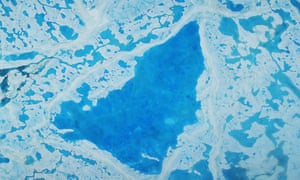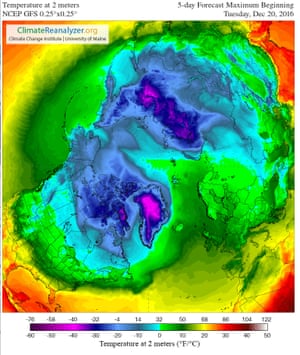Extract from The Guardian
Temperatures in parts of the Arctic are expected to rise above 0C for the second winter in a rowA large pool of meltwater over sea ice in the Beaufort Sea in July. Scientists say parts of the Arctic will climb above water’s freezing temperature over the next few days. Photograph: Operation IceBridge/Nasa
Michael Slezak
Thursday 22 December 2016 02.00 AEDT
Scientists are forecasting ice-melting temperatures in the middle of winter for some parts of the Arctic for the second year in a row. And analysis shows such recent record temperatures there would have been virtually impossible without human greenhouse emissions.
The five-day forecast maximum temperatures over the Arctic from Tuesday 20 December 2016. Photograph: ClimateReanalyzer.org/Climate change institute, University of Maine
Over the coming days, some parts of the Arctic are expected to get gusts of warm air that are more than 20C hotter than usual for this time of year, some of which will tip over the 0C melting temperature of water.
Maximum temperatures in parts of the Arctic will be warmer than the maximum over most of Canada for the next five days, according the global forecasting system run by the US National Oceanographic and Atmospheric Administration (Noaa).
The extreme temperatures predicted coincide with record low sea-ice levels in the Arctic, which have already been wreaking havoc with weather North America, Europe and Asia, according to leading climate scientists.
A low pressure system near Greenland is pulling the warm air towards the Arctic, in a similar pattern to that seen in 2015. And a paper published this month showed events like that, called “midwinter warming”, were occurring more frequently, and made more likely by the loss of winter sea ice – something itself caused by climate change. With less ice, warm air moved closer to the Arctic and could then more easily be swept over it, the scientists claimed.
“These are very strange temperatures and are getting very close to hitting the freezing point, which is incredible for this time of year,” said Andrew King, a climate scientist from the University of Melbourne in Australia.
But it’s not just predicted maximum temperatures that have been extreme. November and December have seen record average temperatures over the Arctic, averaging 2.5C above the usual for this time of year.
Temperature anomalies like that have been linked to changes in migration patterns of marine mammals, cause mass starvation and deaths of reindeer as well as impact the habitats of polar bears.
Now King and colleagues have shown the recent extreme average temperatures are almost certainly caused by climate change. And while they are still rare events – expected once every 200 years – they will be average by the year 2040.
King and colleagues compared model simulations with and without the influence of human-caused greenhouse gas concentrations.
“The record November-December temperatures in the Arctic are not seen in the natural world simulations where human influences have been removed,” King wrote in a piece published in The Conversation.
“In comparison, in the current climate with human effects included, this event has at least a one-in-200-year return time.”
By the 2040s, the event is expected to occur every second year, on average.
The work has not yet been published in a peer-reviewed journal, but uses methods the team have used several times before in work that has been peer-reviewed.


No comments:
Post a Comment